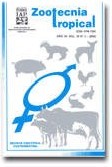
|
Zootecnia Tropical
Instituto Nacional de Investigaciones Agrícolas Venezuela
ISSN: 0798-7269
Vol. 20, No. 3, 2002, pp. 383-395
|
 Bioline Code: zt02025
Bioline Code: zt02025
Full paper language: Spanish
Document type: Research Article
Document available free of charge
|
|
|
Zootecnia Tropical, Vol. 20, No. 3, 2002, pp. 383-395
| en |
Effect of the explotation system on the appearance of mastitis in goat in two farm in Falcon state, their etiologic agents and antimicrobial resistance
Antonia M. Clavijo, Bernavé Meléndez, María L. Clavijo, Alecia Godoy y Jorge Santander
Abstract
With the purpose of determining the effect of farrning system on the presence of mastitis in goats, their etiologic agents and the sensitivity to antirnicrobial, it was carried out this investigation in two farms in Falcon state. One farrn with serni- intensive handling (Farm A) and the other one intensive (Farm B). Staphylococcus aureus

was isolated (62%), Endurichia coli

(10,3%), Streptococcus dysgalactiae

(10,3%), Streptococcus uberis

(6,8%), Enterobacter aerogenes

(6,8%), and Mycoplasma

sp. (3,4%); presenting multiple resistance to the antirnicrobial. Farrn A presented mastitis in 44,4% of the samples, caused by S. aureus (62%), E. aerogenes (25%), and S. dysgalactiae (13%) showing low resistance levels with 4 pattems that included from 2 to 13 markers. complete sensibility was observed AN, C, DP, ENR, G, NB and Te. In Farrn B, mastitis was present in 87% of the samples. S. aureus (61%), E. coli (14%), St. dysgalactiae (10%), St. uberis (10%) and Mycoplasma sp. (5%) were isolated, showims a high resistance, including pattems from 6 to 19 markers berth momegth antirnicrobial were 100% sensitive. This indicates that farrning system influences in the appearance of mastitis, because cohen is intensive and the biosecurity measures are not completed, more cases of mastitis take place being necessary to know the changes in the bacterial ecology and in the resistance to antirnicrobial, in each farm, to recommend efficient therapies.
mastitis, goat, antimicrobial, susceptibility
|
| |
| es |
Efecto del sistema de explotación sobre la aparición de mastitis caprina en dos fincas del estado Falcón, sus agentes etiológicos y la resistencia a antimicrobianos
Antonia M. Clavijo, Bernavé Meléndez, María L. Clavijo, Alecia Godoy y Jorge Santander
Resumen
Con la finalidad de determinar el efecto del sistema de explotación sobre la presencia de mastitis caprina, sus agentes etiológicos y la sensibilidad a antirnicrobianos, se realizó esta investigación en dos fincas del estado Falcón, una con manejo serni-intensivo (Finca A) y la otra intensivo (Finca B). Se aisló Staphylococcus aureus

(62%), Echerichia coli

(10,3%), Streptococcus dysgalactiae

(10,3%), Streptococcus uberis

(6,8%), Enterobacter aerogenes

(6,8%) y Mycoplasma

sp. (3,4%), presentando resistencia múltiple a los antirnicrobianos. La Finca A presentó mastitis en 44,4% de las muestras, causada por S. aureus (62%), E. aerogenes (25%) y Streptococus dysgalactiae (13%) mostrando bajos niveles de resistencia con 4 patrones que incluyeron de 2 a 13 marcadores. Se observó 100% de sensibilidad a amikacina, cloranfenicol, danofloxacina, enrofloxacina, gentarnicina, novobiocina y tetraciclina. En la Finca B se diagnosticó mastitis en 87% de las muestras. Se aisló S. aureus (61 %), E. coli (14%), S. dysgalactiae (10%), S. uberis (10%) y Mycoplasma sp. (5%) con alta resistencia incluyendo patrones de 6 a 19 marcadores sin que hubiese ningún antimicrobiano totalmente sensible. Esto indica que el manejo influye en la aparición de mastitis, pues cuando sea más intensivo y no se cumplan las medidas de bioseguridad, se producirán más casos de mastitis siendo necesario conocer los cambios en la ecología bacteriana y en la resistencia a antimicrobianos, en cada finca, para recomendar terapias eficientes.
mastitis, caprinos, antimicrobianos, susceptibilidad
|
| |
© Copyright 2002 - Zootecnica Tropical. Free full-text also available online at http://www.ceniap.gov.ve/bdigital/ztzoo/ztindice.htm
Alternative site location: http://www.sian.inia.gob.ve/repositorio/revistas_ci/ZootecniaTropical/ztindice.htm
|
|
